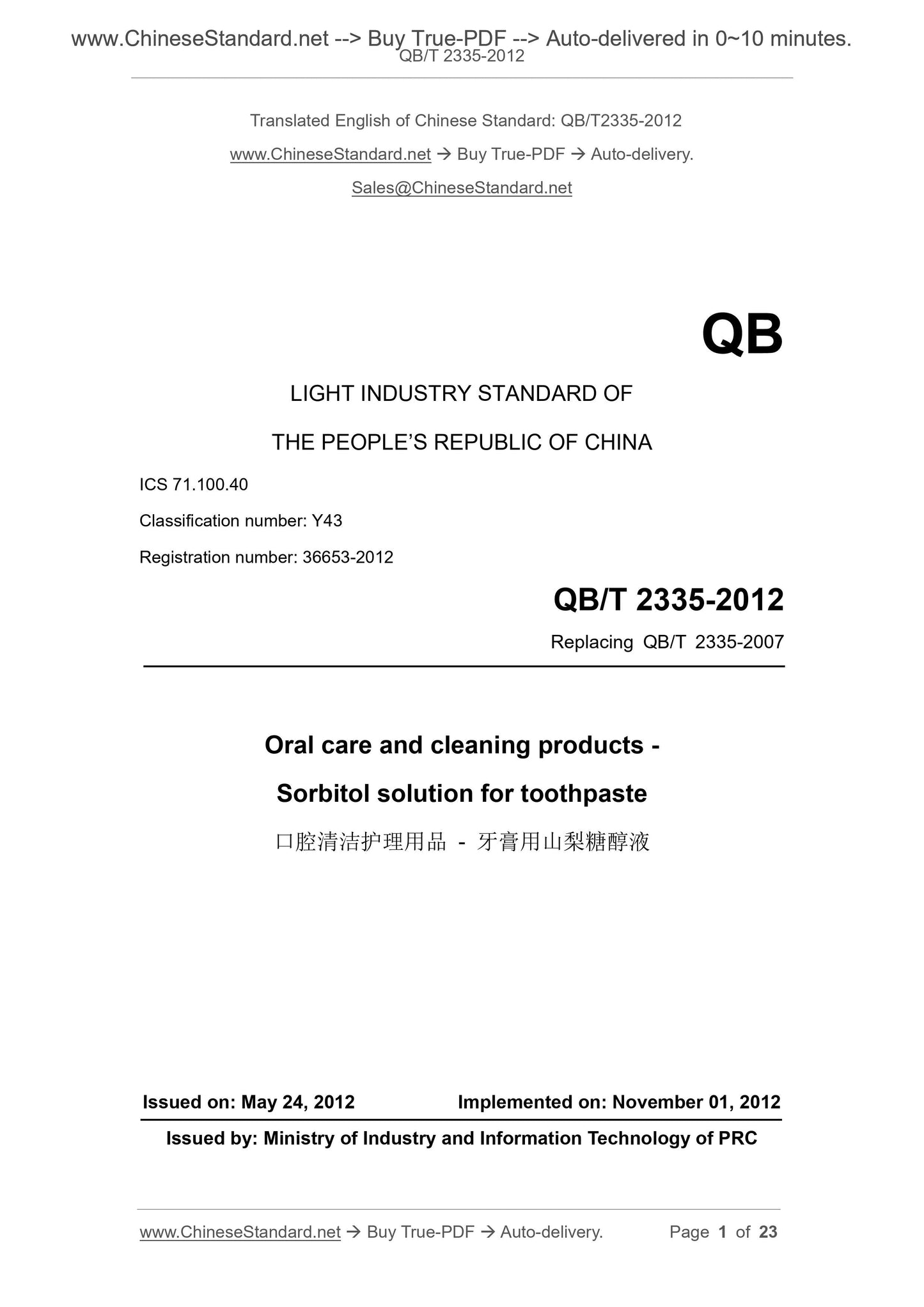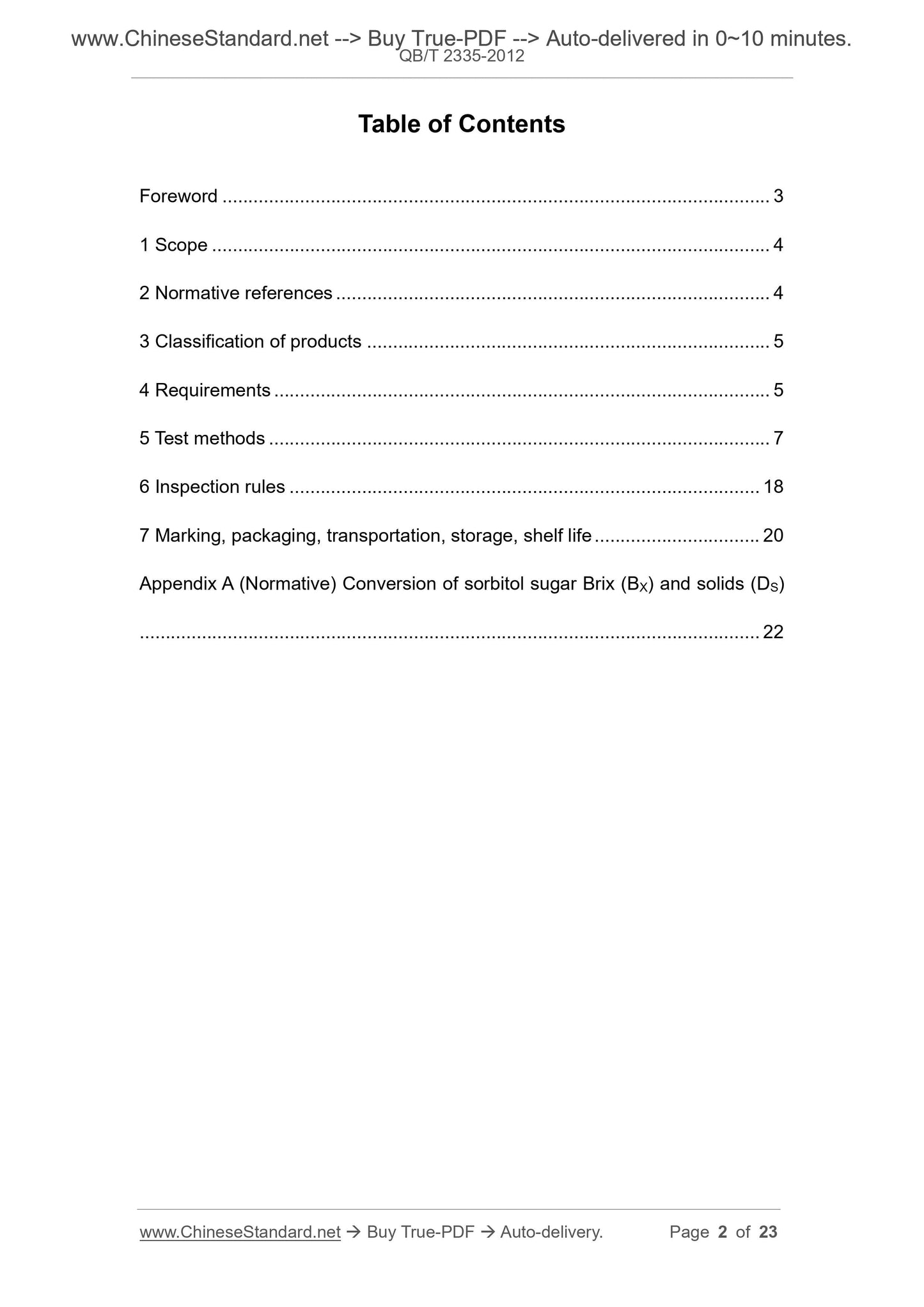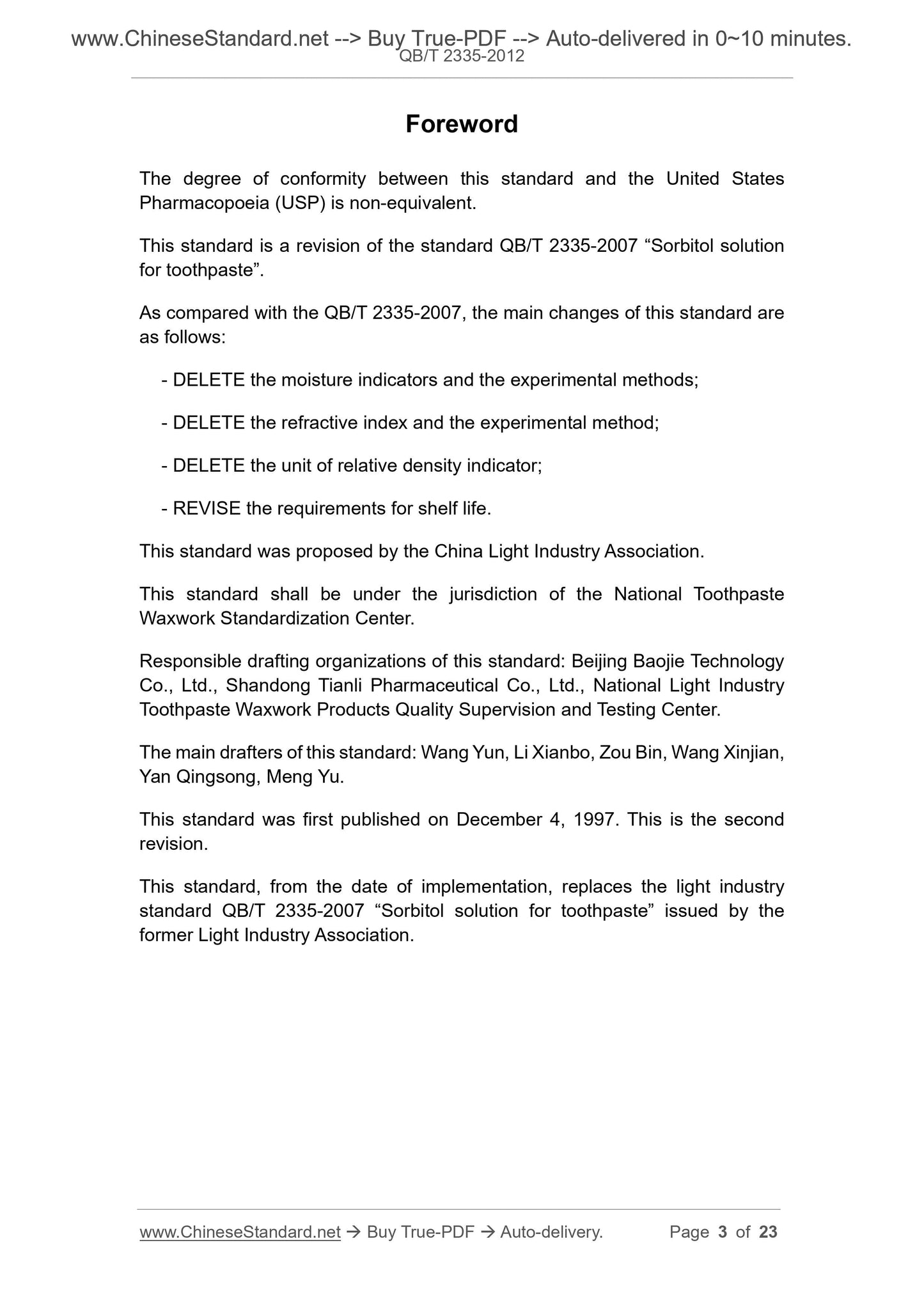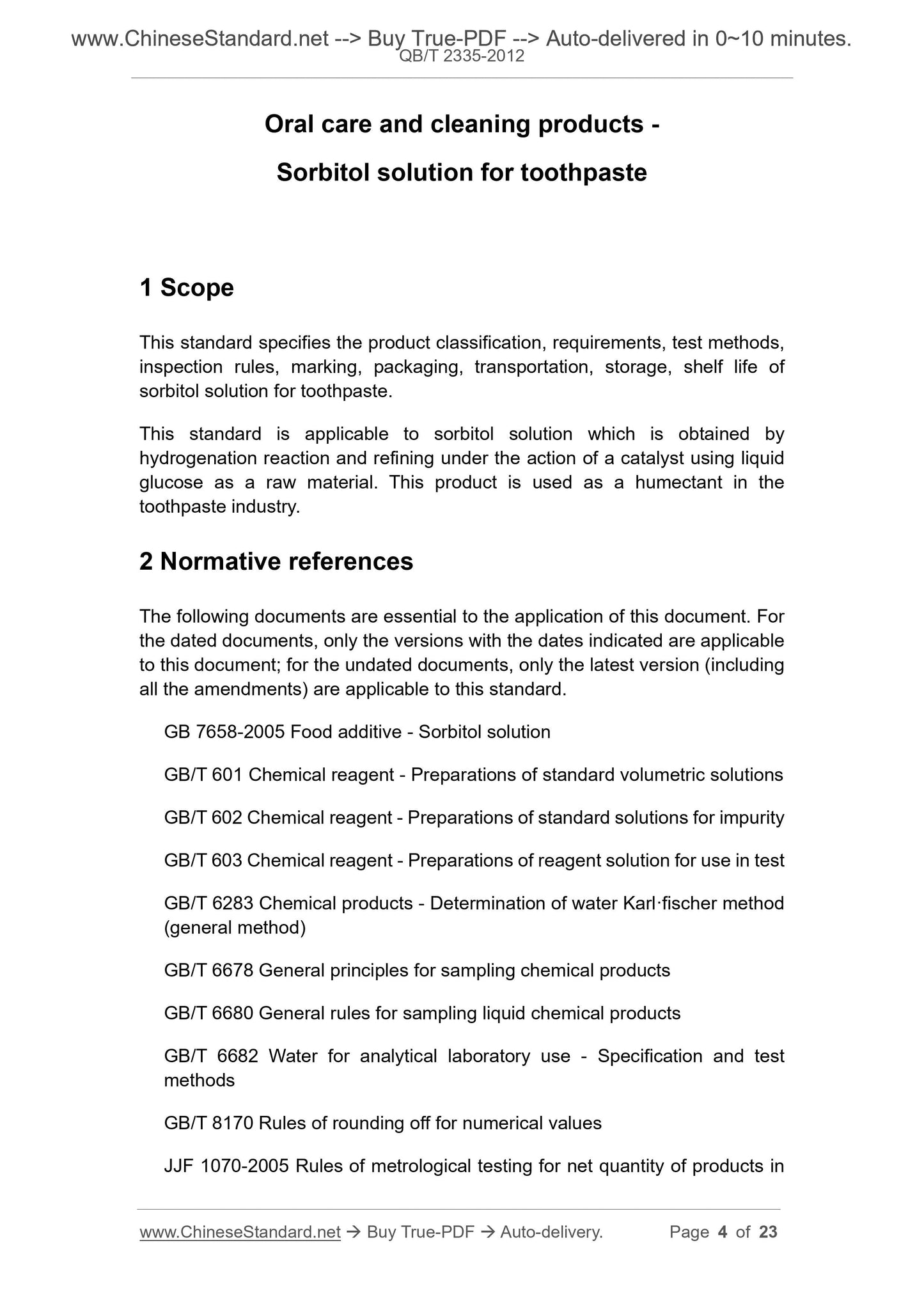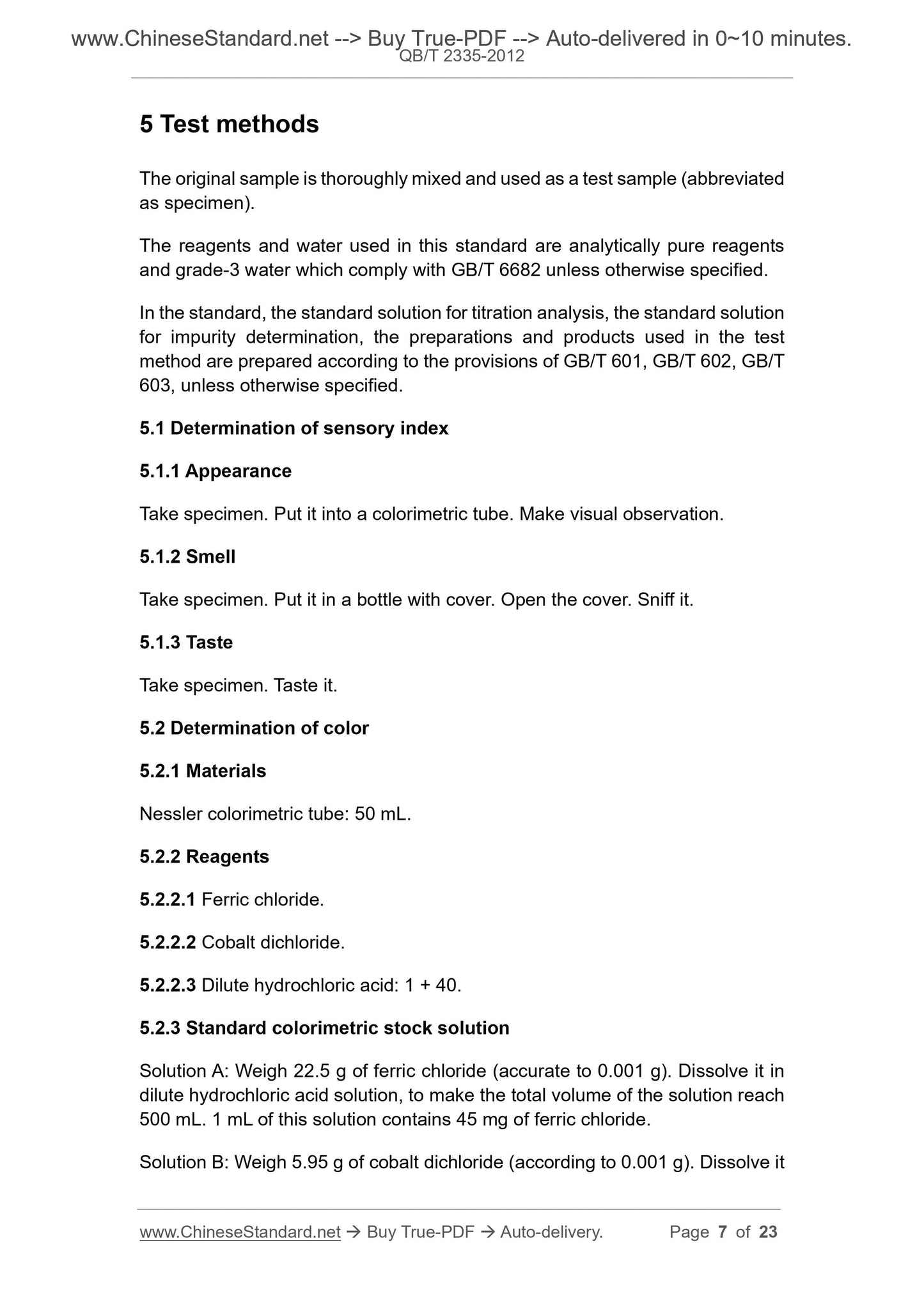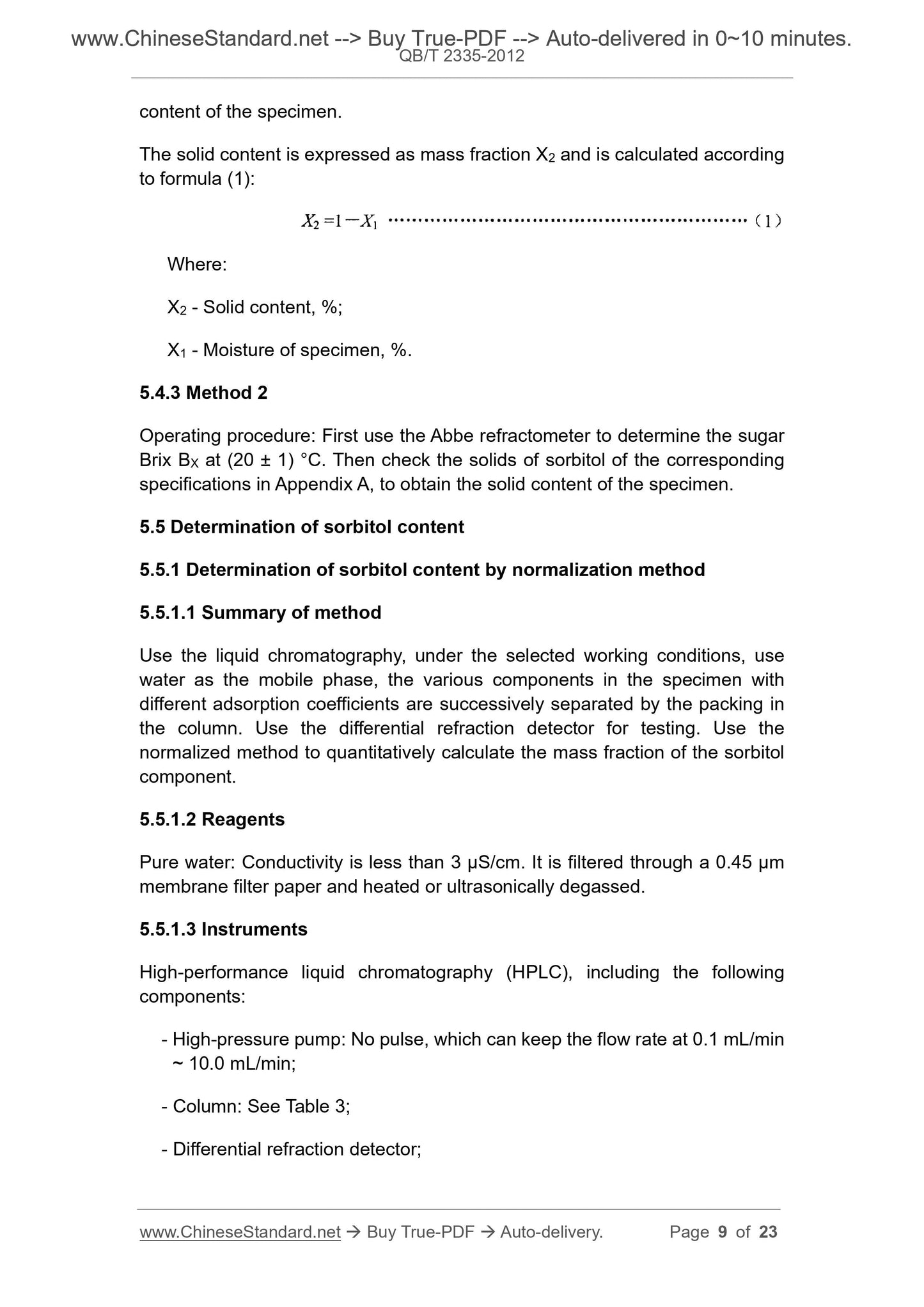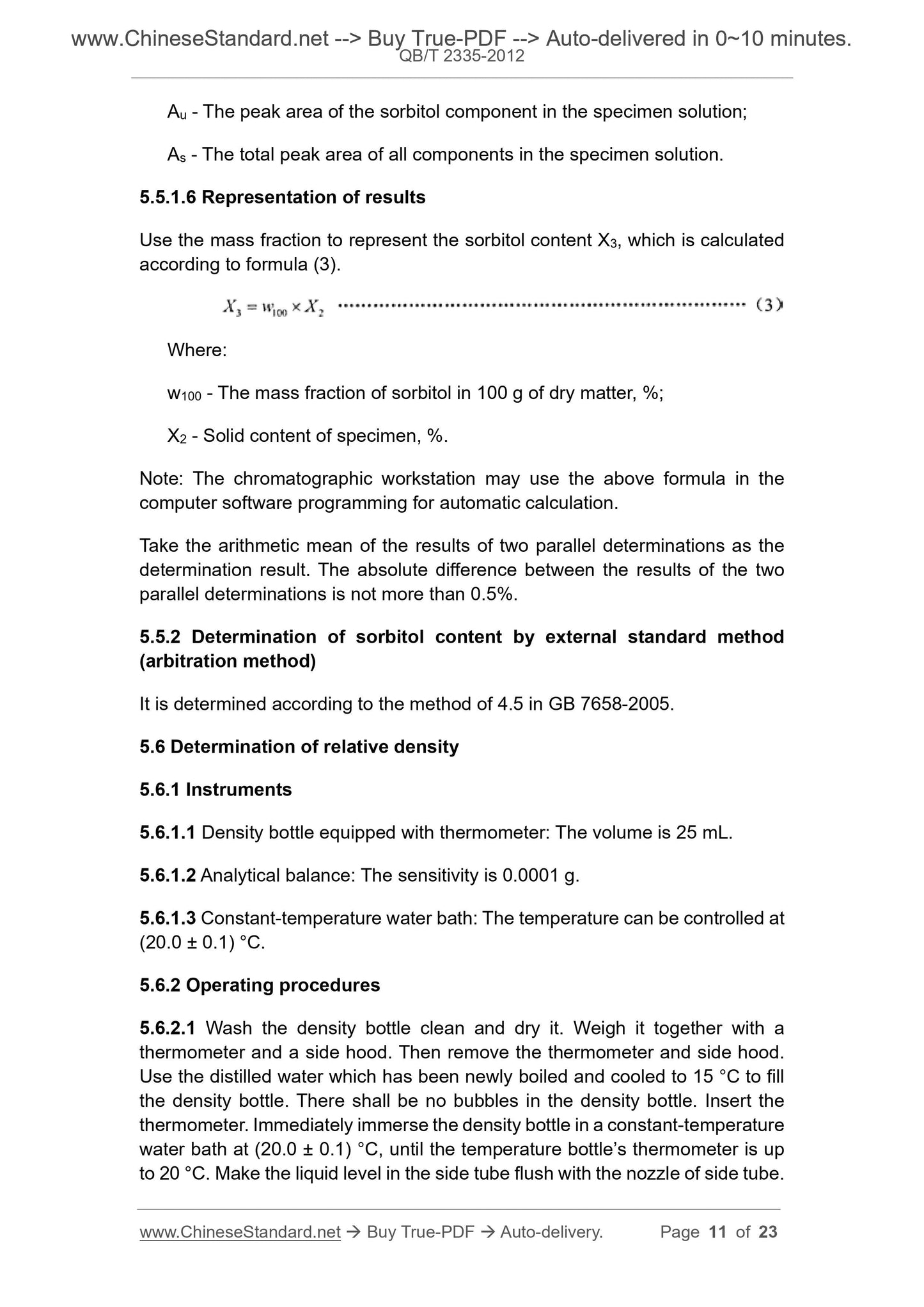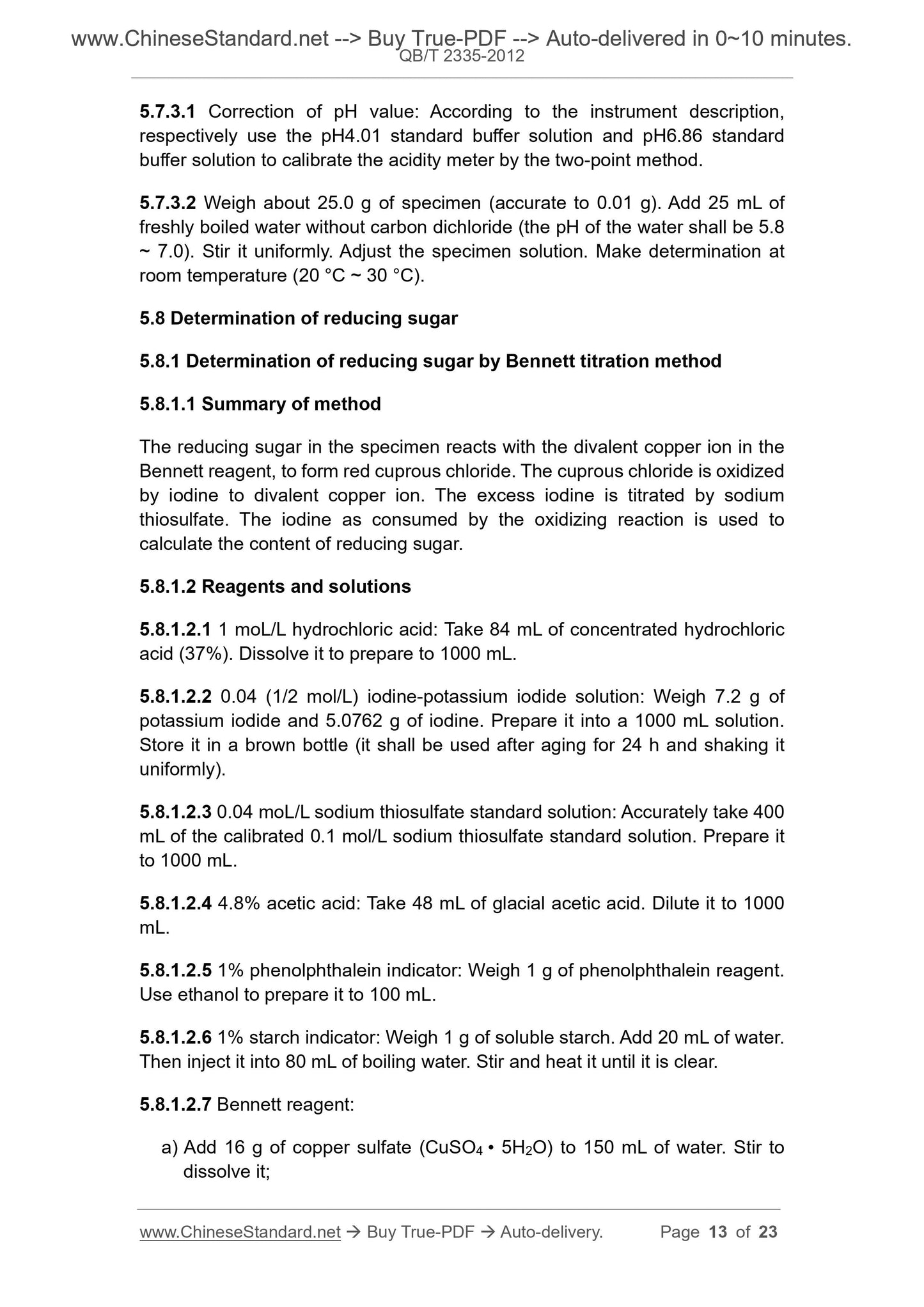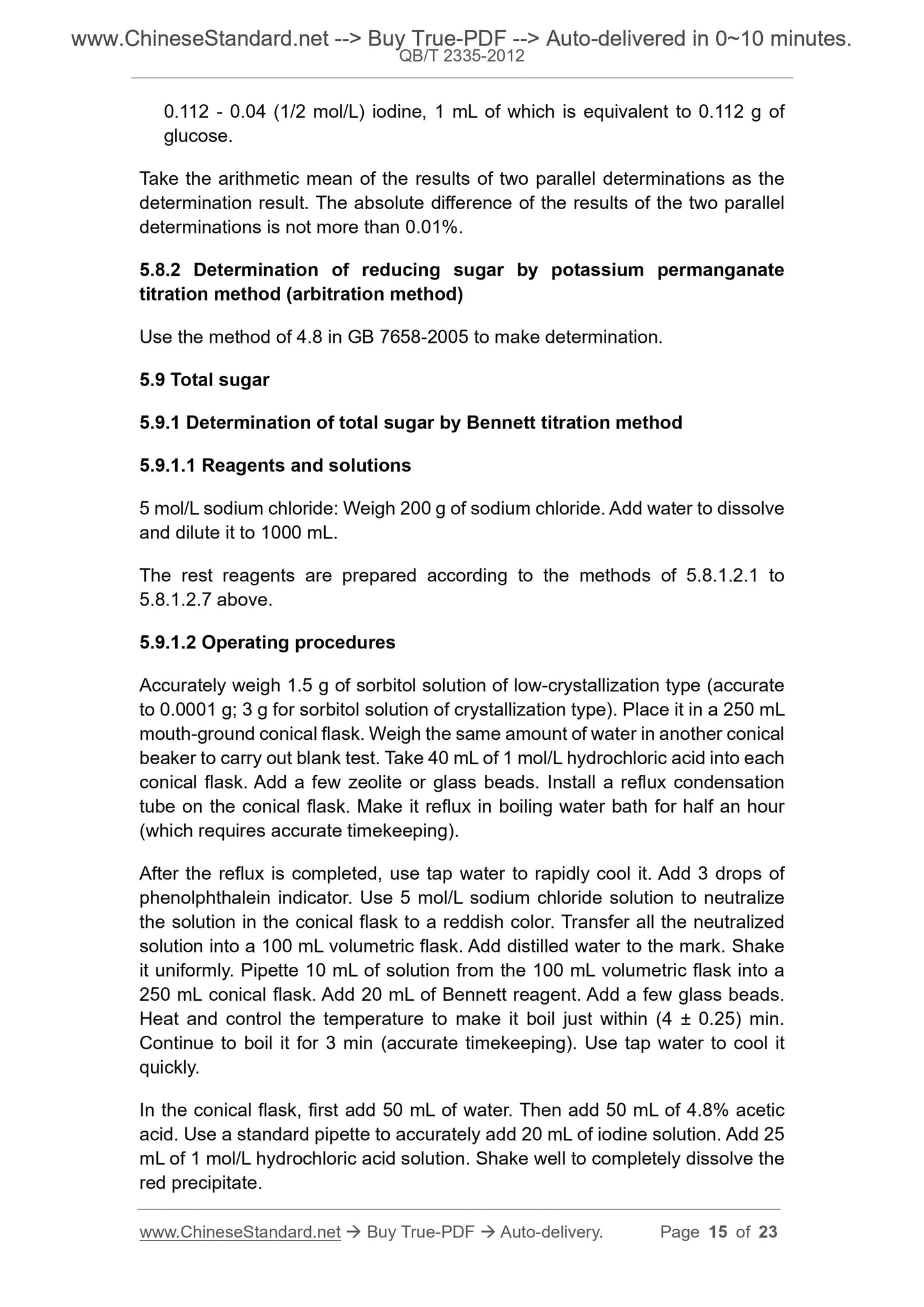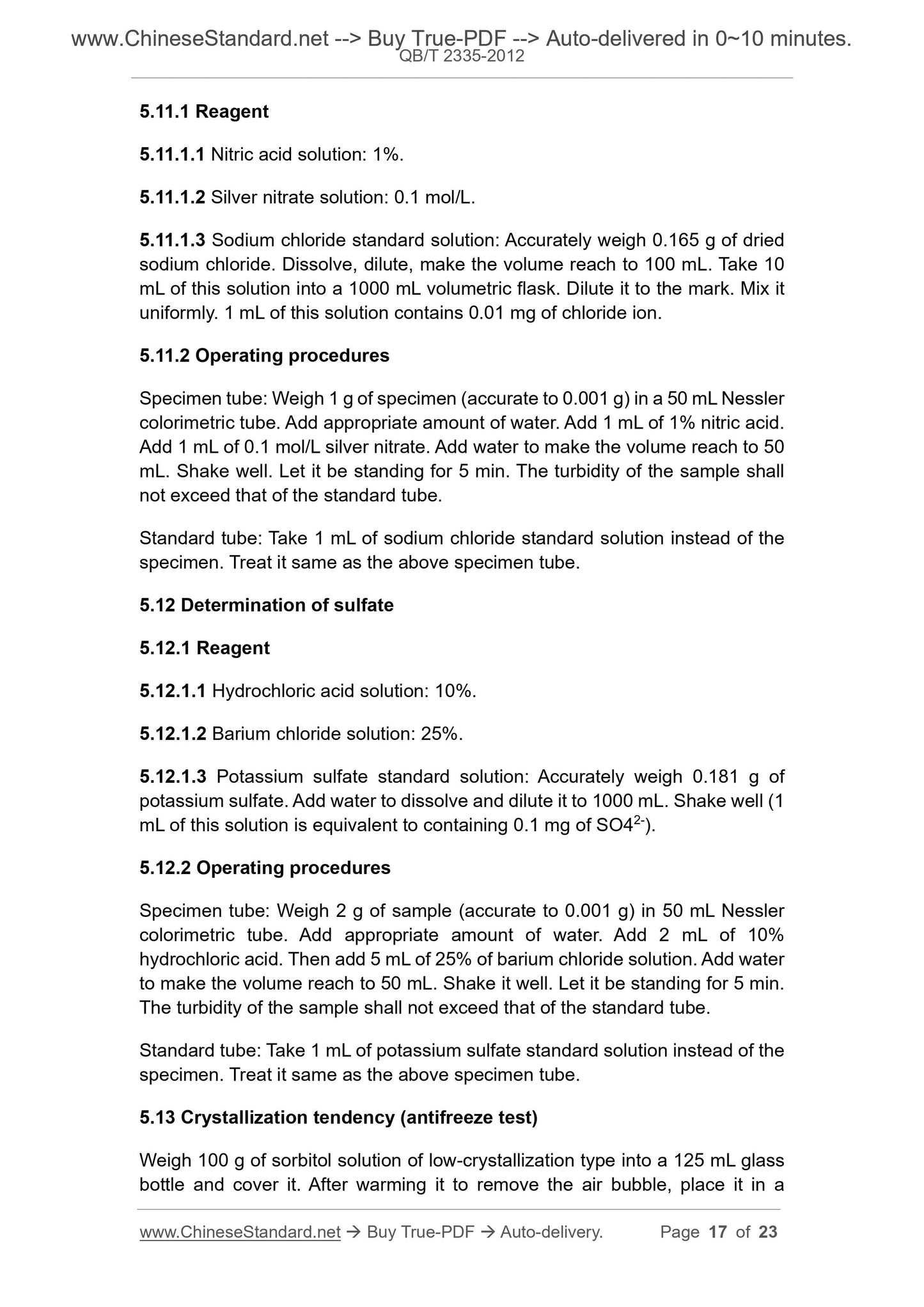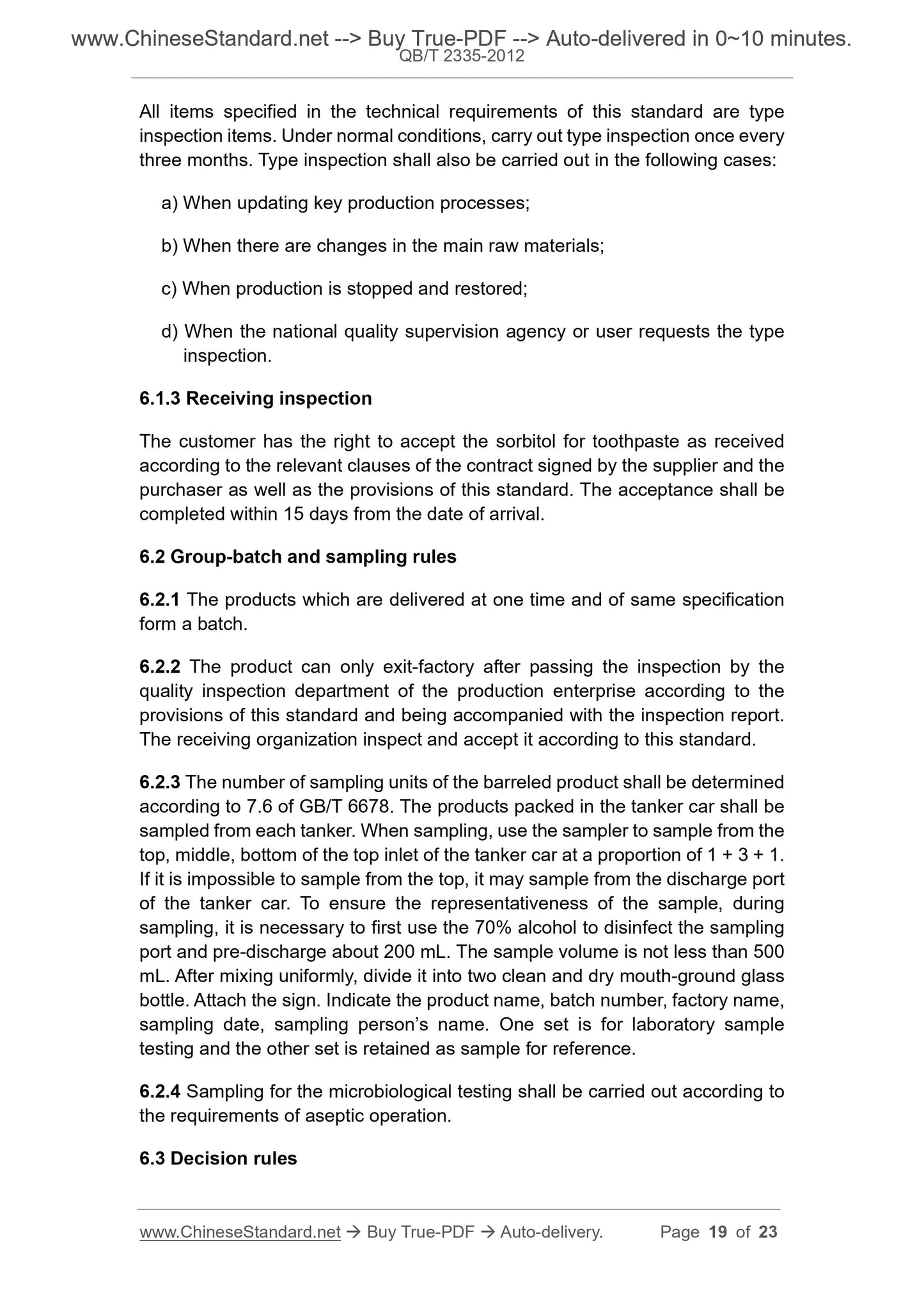1
/
of
11
www.ChineseStandard.us -- Field Test Asia Pte. Ltd.
QB/T 2335-2012 English PDF (QB/T2335-2012)
QB/T 2335-2012 English PDF (QB/T2335-2012)
Regular price
$145.00
Regular price
Sale price
$145.00
Unit price
/
per
Shipping calculated at checkout.
Couldn't load pickup availability
QB/T 2335-2012: Oral care and cleaning products - Sorbitol solution for toothpaste
Delivery: 9 seconds. Download (& Email) true-PDF + Invoice.
Get Quotation: Click QB/T 2335-2012 (Self-service in 1-minute)
Historical versions (Master-website): QB/T 2335-2012
Preview True-PDF (Reload/Scroll-down if blank)
QB/T 2335-2012
LIGHT INDUSTRY STANDARD OF
THE PEOPLE’S REPUBLIC OF CHINA
ICS 71.100.40
Classification number: Y43
Registration number: 36653-2012
Replacing QB/T 2335-2007
Oral care and cleaning products -
Sorbitol solution for toothpaste
ISSUED ON: MAY 24, 2012
IMPLEMENTED ON: NOVEMBER 01, 2012
Issued by: Ministry of Industry and Information Technology of PRC
Table of Contents
Foreword ... 3
1 Scope ... 4
2 Normative references ... 4
3 Classification of products ... 5
4 Requirements ... 5
5 Test methods ... 7
6 Inspection rules ... 18
7 Marking, packaging, transportation, storage, shelf life ... 20
Appendix A (Normative) Conversion of sorbitol sugar Brix (BX) and solids (DS)
... 22
Foreword
The degree of conformity between this standard and the United States
Pharmacopoeia (USP) is non-equivalent.
This standard is a revision of the standard QB/T 2335-2007 “Sorbitol solution
for toothpaste”.
As compared with the QB/T 2335-2007, the main changes of this standard are
as follows:
- DELETE the moisture indicators and the experimental methods;
- DELETE the refractive index and the experimental method;
- DELETE the unit of relative density indicator;
- REVISE the requirements for shelf life.
This standard was proposed by the China Light Industry Association.
This standard shall be under the jurisdiction of the National Toothpaste
Waxwork Standardization Center.
Responsible drafting organizations of this standard: Beijing Baojie Technology
Co., Ltd., Shandong Tianli Pharmaceutical Co., Ltd., National Light Industry
Toothpaste Waxwork Products Quality Supervision and Testing Center.
The main drafters of this standard: Wang Yun, Li Xianbo, Zou Bin, Wang Xinjian,
Yan Qingsong, Meng Yu.
This standard was first published on December 4, 1997. This is the second
revision.
This standard, from the date of implementation, replaces the light industry
standard QB/T 2335-2007 “Sorbitol solution for toothpaste” issued by the
former Light Industry Association.
Oral care and cleaning products -
Sorbitol solution for toothpaste
1 Scope
This standard specifies the product classification, requirements, test methods,
inspection rules, marking, packaging, transportation, storage, shelf life of
sorbitol solution for toothpaste.
This standard is applicable to sorbitol solution which is obtained by
hydrogenation reaction and refining under the action of a catalyst using liquid
glucose as a raw material. This product is used as a humectant in the
toothpaste industry.
2 Normative references
The following documents are essential to the application of this document. For
the dated documents, only the versions with the dates indicated are applicable
to this document; for the undated documents, only the latest version (including
all the amendments) are applicable to this standard.
GB 7658-2005 Food additive - Sorbitol solution
GB/T 601 Chemical reagent - Preparations of standard volumetric solutions
GB/T 602 Chemical reagent - Preparations of standard solutions for impurity
GB/T 603 Chemical reagent - Preparations of reagent solution for use in test
GB/T 6283 Chemical products - Determination of water Karl·fischer method
(general method)
GB/T 6678 General principles for sampling chemical products
GB/T 6680 General rules for sampling liquid chemical products
GB/T 6682 Water for analytical laboratory use - Specification and test
methods
GB/T 8170 Rules of rounding off for numerical values
JJF 1070-2005 Rules of metrological testing for net quantity of products in
5 Test methods
The original sample is thoroughly mixed and used as a test sample (abbreviated
as specimen).
The reagents and water used in this standard are analytically pure reagents
and grade-3 water which comply with GB/T 6682 unless otherwise specified.
In the standard, the standard solution for titration analysis, the standard solution
for impurity determination, the preparations and products used in the test
method are prepared according to the provisions of GB/T 601, GB/T 602, GB/T
603, unless otherwise specified.
5.1 Determination of sensory index
5.1.1 Appearance
Take specimen. Put it into a colorimetric tube. Make visual observation.
5.1.2 Smell
Take specimen. Put it in a bottle with cover. Open the cover. Sniff it.
5.1.3 Taste
Take specimen. Taste it.
5.2 Determination of color
5.2.1 Materials
Nessler colorimetric tube: 50 mL.
5.2.2 Reagents
5.2.2.1 Ferric chloride.
5.2.2.2 Cobalt dichloride.
5.2.2.3 Dilute hydrochloric acid: 1 + 40.
5.2.3 Standard colorimetric stock solution
Solution A: Weigh 22.5 g of ferric chloride (accurate to 0.001 g). Dissolve it in
dilute hydrochloric acid solution, to make the total volume of the solution reach
500 mL. 1 mL of this solution contains 45 mg of ferric chloride.
Solution B: Weigh 5.95 g of cobalt dichloride (according to 0.001 g). Dissolve it
content of the specimen.
The solid content is expressed as mass fraction X2 and is calculated according
to formula (1):
Where:
X2 - Solid content, %;
X1 - Moisture of specimen, %.
5.4.3 Method 2
Operating procedure: First use the Abbe refractometer to determine the sugar
Brix BX at (20 ± 1) °C. Then check the solids of sorbitol of the corresponding
specifications in Appendix A, to obtain the solid content of the specimen.
5.5 Determination of sorbitol content
5.5.1 Determination of sorbitol content by normalization method
5.5.1.1 Summary of method
Use the liquid chromatography, under the selected working conditions, use
water as the mobile phase, the various components in the specimen with
different adsorption coefficients are successively separated by the packing in
the column. Use the differential refraction detector for testing. Use the
normalized method to quantitatively calculate the mass fraction of the sorbitol
component.
5.5.1.2 Reagents
Pure water: Conductivity is less than 3 μS/cm. It is filtered through a 0.45 μm
membrane filter paper and heated or ultrasonically degassed.
5.5.1.3 Instruments
High-performance liquid chromatography (HPLC), including the following
components:
- High-pressure pump: No pulse, which can keep the flow rate at 0.1 mL/min
~ 10.0 mL/min;
- Column: See Table 3;
- Differential refraction detector;
Au - The peak area of the sorbitol component in the specimen solution;
As - The total peak area of all components in the specimen solution.
5.5.1.6 Representation of results
Use the mass fraction to represent the sorbitol content X3, which is calculated
according to formula (3).
Where:
w100 - The mass fraction of sorbitol in 100 g of dry matter, %;
X2 - Solid content of specimen, %.
Note: The chromatographic workstation may use the above formula in the
computer software programming for automatic calculation.
Take the arithmetic mean of the results of two parallel determinations as the
determination result. The absolute difference between the results of the two
parallel determinations is not more than 0.5%.
5.5.2 Determination of sorbitol content by external standard method
(arbitration method)
It is determined according to the method of 4.5 in GB 7658-2005.
5.6 Determination of relative density
5.6.1 Instruments
5.6.1.1 Density bottle equipped with thermometer: The volume is 25 mL.
5.6.1.2 Analytical balance: The sensitivity is 0.0001 g.
5.6.1.3 Constant-temperature water bath: The temperature can be controlled at
(20.0 ± 0.1) °C.
5.6.2 Operating procedures
5.6.2.1 Wash the density bottle clean and dry it. Weigh it together with a
thermometer and a side hood. Then remove the thermometer and side hood.
Use the distilled water which has been newly boiled and cooled to 15 °C to fill
the density bottle. There shall be no bubbles in the density bottle. Insert the
thermometer. Immediately immerse the density bottle in a constant-temperature
water bath at (20.0 ± 0.1) °C, until the temperature bottle’s thermometer is up
to 20 °C. Make the liquid level in the side tube flush with the nozzle of side tube.
5.7.3.1 Correction of pH value: According to the instrument description,
respectively use the pH4.01 standard buffer solution and pH6.86 standard
buffer solution to calibrate the acidity meter by the two-point method.
5.7.3.2 Weigh about 25.0 g of specimen (accurate to 0.01 g). Add 25 mL of
freshly boiled water without carbon dichloride (the pH of the water shall be 5.8
~ 7.0). Stir it uniformly. Adjust the specimen solution. Make determination at
room temperature (20 °C ~ 30 °C).
5.8 Determination of reducing sugar
5.8.1 Determination of reducing sugar by Bennett titration method
5.8.1.1 Summary of method
The reducing sugar in the specimen reacts with the divalent copper ion in the
Bennett reagent, to form red cuprous chloride. The cuprous chloride is oxidized
by iodine to divalent copper ion. The excess iodine is titrated by sodium
thiosulfate. The iodine as consumed by the oxidizing reaction is used to
calculate the content of reducing sugar.
5.8.1.2 Reagents and solutions
5.8.1.2.1 1 moL/L hydrochloric acid: Take 84 mL of concentrated hydrochloric
acid (37%). Dissolve it to prepare to 1000 mL.
5.8.1.2.2 0.04 (1/2 mol/L) iodine-potassium iodide solution: Weigh 7.2 g of
potassium iodide and 5.0762 g of iodine. Prepare it into a 1000 mL solution.
Store it in a brown bottle (it shall be used after aging for 24 h and shaking it
uniformly).
5.8.1.2.3 0.04 moL/L sodium thiosulfate standard solution: Accurately take 400
mL of the calibrated 0.1 mol/L sodium thiosulfate standard solution. Prepare it
to 1000 mL.
5.8.1.2.4 4.8% acetic acid: Take 48 mL of glacial acetic acid. Dilute it to 1000
mL.
5.8.1.2.5 1% phenolphthalein indicator: Weigh 1 g of phenolphthalein reagent.
Use ethanol to prepare it to 100 mL.
5.8.1.2.6 1% starch indicator: Weigh 1 g of soluble starch. Add 20 mL of water.
Then inject it into 80 mL of boiling water. Stir and heat it until it is clear.
5.8.1.2.7 Bennett reagent:
a) Add 16 g of copper sulfate (CuSO4 • 5H2O) to 150 mL of water. Stir to
dissolve it;
0.112 - 0.04 (1/2 mol/L) iodine, 1 mL of which is equivalent to 0.112 g of
glucose.
Take the arithmetic mean of the results of two parallel determinations as the
determination result. The absolute difference of the results of the two parallel
determinations is not more than 0.01%.
5.8.2 Determination of reducing sugar by potassium permanganate
titration method (arbitration method)
Use the method of 4.8 in GB 7658-2005 to make determination.
5.9 Total sugar
5.9.1 Determination of total sugar by Bennett titration method
5.9.1.1 Reagents and solutions
5 mol/L sodium chloride: Weigh 200 g of sodium chloride. Add water to dissolve
and dilute it to 1000 mL.
The rest reagents are prepared according to the methods of 5.8.1.2.1 to
5.8.1.2.7 above.
5.9.1.2 Operating procedures
Accurately weigh 1.5 g of sorbitol solution of low-crystallization type (accurate
to 0.0001 g; 3 g for sorbitol solution of crystallization type). Place it in a 250 mL
mouth-ground conical flask. Weigh the same amount of water in another conical
beaker to carry out blank test. Take 40 mL of 1 mol/L hydrochloric acid into each
conical flask. Add a few zeolite or glass beads. Install a reflux condensation
tube on the conical flask. Make it reflux in boiling water bath for half an hour
(which requires accurate timekeeping).
After the reflux is completed, use tap water to rapidly cool it. Add 3 drops of
phenolphthalein indicator. Use 5 mol/L sodium chloride solution to neutralize
the solution in the conical flask to a reddish color. Transfer all the neutralized
solution into a 100 mL volumetric flask. Add distilled water to the mark. Shake
it uniformly. Pipette 10 mL of solution from the 100 mL volumetric flask into a
250 mL conical flask. Add 20 mL of Bennett reagent. Add a few glass beads.
Heat and control the temperature to make it boil just within (4 ± 0.25) min.
Continue to boil it for 3 min (accurate timekeeping). Use tap water to cool it
quickly.
In the conical flask, first add 50 mL of water. Then add 50 mL of 4.8% acetic
acid. Use a standard pipette to accurately add 20 mL of iodine solution. Add 25
mL of 1 mol/L hydrochloric acid solution. Shake well to completely dissolve the
red precipitate.
5.11.1 Reagent
5.11.1.1 Nitric acid solution: 1%.
5.11.1.2 Silver nitrate solution: 0.1 mol/L.
5.11.1.3 Sodium chloride standard solution: Accurately weigh 0.165 g of dried
sodium chloride. Dissolve, dilute, make the volume reach to 100 mL. Take 10
mL of this solution into a 1000 mL volumetric flask. Dilute it to the mark. Mix it
uniformly. 1 mL of this solution contains 0.01 mg of chloride ion.
5.11.2 Operating procedures
Specimen tube: Weigh 1 g of specimen (accurate to 0.001 g) in a 50 mL Nessler
colorimetric tube. Add appropriate amount of water. Add 1 mL of 1% nitric acid.
Add 1 mL of 0.1 mol/L silver nitrate. Add water to make the volume reach to 50
mL. Shake well. Let it be standing for 5 min. The turbidity of the sample shall
not exceed that of the standard tube.
Standard tube: Take 1 mL of sodium chloride standard solution instead of the
specimen. Treat it same as the above specimen tube.
5.12 Determination of sulfate
5.12.1 Reagent
5.12.1.1 Hydrochloric acid solution: 10%.
5.12.1.2 Barium chloride solution: 25%.
5.12.1.3 Potassium sulfate standard solution: Accurately weigh 0.181 g of
potassium sulfate. Add water to dissolve and dilute it to 1000 mL. Shake well (1
mL of this solution is equivalent to containing 0.1 mg of SO42-).
5.12.2 Operating procedures
Specimen tube: Weigh 2 g of sample (accurate to 0.001 g) in 50 mL Nessler
colorimetric tube. Add appropriate amount of water. Add 2 mL of 10%
hydrochloric acid. Then add 5 mL of 25% of barium chloride solution. Add water
to make the volume reach to 50 mL. Shake it well. Let it be standing for 5 min.
The turbidity of the sample s...
Delivery: 9 seconds. Download (& Email) true-PDF + Invoice.
Get Quotation: Click QB/T 2335-2012 (Self-service in 1-minute)
Historical versions (Master-website): QB/T 2335-2012
Preview True-PDF (Reload/Scroll-down if blank)
QB/T 2335-2012
LIGHT INDUSTRY STANDARD OF
THE PEOPLE’S REPUBLIC OF CHINA
ICS 71.100.40
Classification number: Y43
Registration number: 36653-2012
Replacing QB/T 2335-2007
Oral care and cleaning products -
Sorbitol solution for toothpaste
ISSUED ON: MAY 24, 2012
IMPLEMENTED ON: NOVEMBER 01, 2012
Issued by: Ministry of Industry and Information Technology of PRC
Table of Contents
Foreword ... 3
1 Scope ... 4
2 Normative references ... 4
3 Classification of products ... 5
4 Requirements ... 5
5 Test methods ... 7
6 Inspection rules ... 18
7 Marking, packaging, transportation, storage, shelf life ... 20
Appendix A (Normative) Conversion of sorbitol sugar Brix (BX) and solids (DS)
... 22
Foreword
The degree of conformity between this standard and the United States
Pharmacopoeia (USP) is non-equivalent.
This standard is a revision of the standard QB/T 2335-2007 “Sorbitol solution
for toothpaste”.
As compared with the QB/T 2335-2007, the main changes of this standard are
as follows:
- DELETE the moisture indicators and the experimental methods;
- DELETE the refractive index and the experimental method;
- DELETE the unit of relative density indicator;
- REVISE the requirements for shelf life.
This standard was proposed by the China Light Industry Association.
This standard shall be under the jurisdiction of the National Toothpaste
Waxwork Standardization Center.
Responsible drafting organizations of this standard: Beijing Baojie Technology
Co., Ltd., Shandong Tianli Pharmaceutical Co., Ltd., National Light Industry
Toothpaste Waxwork Products Quality Supervision and Testing Center.
The main drafters of this standard: Wang Yun, Li Xianbo, Zou Bin, Wang Xinjian,
Yan Qingsong, Meng Yu.
This standard was first published on December 4, 1997. This is the second
revision.
This standard, from the date of implementation, replaces the light industry
standard QB/T 2335-2007 “Sorbitol solution for toothpaste” issued by the
former Light Industry Association.
Oral care and cleaning products -
Sorbitol solution for toothpaste
1 Scope
This standard specifies the product classification, requirements, test methods,
inspection rules, marking, packaging, transportation, storage, shelf life of
sorbitol solution for toothpaste.
This standard is applicable to sorbitol solution which is obtained by
hydrogenation reaction and refining under the action of a catalyst using liquid
glucose as a raw material. This product is used as a humectant in the
toothpaste industry.
2 Normative references
The following documents are essential to the application of this document. For
the dated documents, only the versions with the dates indicated are applicable
to this document; for the undated documents, only the latest version (including
all the amendments) are applicable to this standard.
GB 7658-2005 Food additive - Sorbitol solution
GB/T 601 Chemical reagent - Preparations of standard volumetric solutions
GB/T 602 Chemical reagent - Preparations of standard solutions for impurity
GB/T 603 Chemical reagent - Preparations of reagent solution for use in test
GB/T 6283 Chemical products - Determination of water Karl·fischer method
(general method)
GB/T 6678 General principles for sampling chemical products
GB/T 6680 General rules for sampling liquid chemical products
GB/T 6682 Water for analytical laboratory use - Specification and test
methods
GB/T 8170 Rules of rounding off for numerical values
JJF 1070-2005 Rules of metrological testing for net quantity of products in
5 Test methods
The original sample is thoroughly mixed and used as a test sample (abbreviated
as specimen).
The reagents and water used in this standard are analytically pure reagents
and grade-3 water which comply with GB/T 6682 unless otherwise specified.
In the standard, the standard solution for titration analysis, the standard solution
for impurity determination, the preparations and products used in the test
method are prepared according to the provisions of GB/T 601, GB/T 602, GB/T
603, unless otherwise specified.
5.1 Determination of sensory index
5.1.1 Appearance
Take specimen. Put it into a colorimetric tube. Make visual observation.
5.1.2 Smell
Take specimen. Put it in a bottle with cover. Open the cover. Sniff it.
5.1.3 Taste
Take specimen. Taste it.
5.2 Determination of color
5.2.1 Materials
Nessler colorimetric tube: 50 mL.
5.2.2 Reagents
5.2.2.1 Ferric chloride.
5.2.2.2 Cobalt dichloride.
5.2.2.3 Dilute hydrochloric acid: 1 + 40.
5.2.3 Standard colorimetric stock solution
Solution A: Weigh 22.5 g of ferric chloride (accurate to 0.001 g). Dissolve it in
dilute hydrochloric acid solution, to make the total volume of the solution reach
500 mL. 1 mL of this solution contains 45 mg of ferric chloride.
Solution B: Weigh 5.95 g of cobalt dichloride (according to 0.001 g). Dissolve it
content of the specimen.
The solid content is expressed as mass fraction X2 and is calculated according
to formula (1):
Where:
X2 - Solid content, %;
X1 - Moisture of specimen, %.
5.4.3 Method 2
Operating procedure: First use the Abbe refractometer to determine the sugar
Brix BX at (20 ± 1) °C. Then check the solids of sorbitol of the corresponding
specifications in Appendix A, to obtain the solid content of the specimen.
5.5 Determination of sorbitol content
5.5.1 Determination of sorbitol content by normalization method
5.5.1.1 Summary of method
Use the liquid chromatography, under the selected working conditions, use
water as the mobile phase, the various components in the specimen with
different adsorption coefficients are successively separated by the packing in
the column. Use the differential refraction detector for testing. Use the
normalized method to quantitatively calculate the mass fraction of the sorbitol
component.
5.5.1.2 Reagents
Pure water: Conductivity is less than 3 μS/cm. It is filtered through a 0.45 μm
membrane filter paper and heated or ultrasonically degassed.
5.5.1.3 Instruments
High-performance liquid chromatography (HPLC), including the following
components:
- High-pressure pump: No pulse, which can keep the flow rate at 0.1 mL/min
~ 10.0 mL/min;
- Column: See Table 3;
- Differential refraction detector;
Au - The peak area of the sorbitol component in the specimen solution;
As - The total peak area of all components in the specimen solution.
5.5.1.6 Representation of results
Use the mass fraction to represent the sorbitol content X3, which is calculated
according to formula (3).
Where:
w100 - The mass fraction of sorbitol in 100 g of dry matter, %;
X2 - Solid content of specimen, %.
Note: The chromatographic workstation may use the above formula in the
computer software programming for automatic calculation.
Take the arithmetic mean of the results of two parallel determinations as the
determination result. The absolute difference between the results of the two
parallel determinations is not more than 0.5%.
5.5.2 Determination of sorbitol content by external standard method
(arbitration method)
It is determined according to the method of 4.5 in GB 7658-2005.
5.6 Determination of relative density
5.6.1 Instruments
5.6.1.1 Density bottle equipped with thermometer: The volume is 25 mL.
5.6.1.2 Analytical balance: The sensitivity is 0.0001 g.
5.6.1.3 Constant-temperature water bath: The temperature can be controlled at
(20.0 ± 0.1) °C.
5.6.2 Operating procedures
5.6.2.1 Wash the density bottle clean and dry it. Weigh it together with a
thermometer and a side hood. Then remove the thermometer and side hood.
Use the distilled water which has been newly boiled and cooled to 15 °C to fill
the density bottle. There shall be no bubbles in the density bottle. Insert the
thermometer. Immediately immerse the density bottle in a constant-temperature
water bath at (20.0 ± 0.1) °C, until the temperature bottle’s thermometer is up
to 20 °C. Make the liquid level in the side tube flush with the nozzle of side tube.
5.7.3.1 Correction of pH value: According to the instrument description,
respectively use the pH4.01 standard buffer solution and pH6.86 standard
buffer solution to calibrate the acidity meter by the two-point method.
5.7.3.2 Weigh about 25.0 g of specimen (accurate to 0.01 g). Add 25 mL of
freshly boiled water without carbon dichloride (the pH of the water shall be 5.8
~ 7.0). Stir it uniformly. Adjust the specimen solution. Make determination at
room temperature (20 °C ~ 30 °C).
5.8 Determination of reducing sugar
5.8.1 Determination of reducing sugar by Bennett titration method
5.8.1.1 Summary of method
The reducing sugar in the specimen reacts with the divalent copper ion in the
Bennett reagent, to form red cuprous chloride. The cuprous chloride is oxidized
by iodine to divalent copper ion. The excess iodine is titrated by sodium
thiosulfate. The iodine as consumed by the oxidizing reaction is used to
calculate the content of reducing sugar.
5.8.1.2 Reagents and solutions
5.8.1.2.1 1 moL/L hydrochloric acid: Take 84 mL of concentrated hydrochloric
acid (37%). Dissolve it to prepare to 1000 mL.
5.8.1.2.2 0.04 (1/2 mol/L) iodine-potassium iodide solution: Weigh 7.2 g of
potassium iodide and 5.0762 g of iodine. Prepare it into a 1000 mL solution.
Store it in a brown bottle (it shall be used after aging for 24 h and shaking it
uniformly).
5.8.1.2.3 0.04 moL/L sodium thiosulfate standard solution: Accurately take 400
mL of the calibrated 0.1 mol/L sodium thiosulfate standard solution. Prepare it
to 1000 mL.
5.8.1.2.4 4.8% acetic acid: Take 48 mL of glacial acetic acid. Dilute it to 1000
mL.
5.8.1.2.5 1% phenolphthalein indicator: Weigh 1 g of phenolphthalein reagent.
Use ethanol to prepare it to 100 mL.
5.8.1.2.6 1% starch indicator: Weigh 1 g of soluble starch. Add 20 mL of water.
Then inject it into 80 mL of boiling water. Stir and heat it until it is clear.
5.8.1.2.7 Bennett reagent:
a) Add 16 g of copper sulfate (CuSO4 • 5H2O) to 150 mL of water. Stir to
dissolve it;
0.112 - 0.04 (1/2 mol/L) iodine, 1 mL of which is equivalent to 0.112 g of
glucose.
Take the arithmetic mean of the results of two parallel determinations as the
determination result. The absolute difference of the results of the two parallel
determinations is not more than 0.01%.
5.8.2 Determination of reducing sugar by potassium permanganate
titration method (arbitration method)
Use the method of 4.8 in GB 7658-2005 to make determination.
5.9 Total sugar
5.9.1 Determination of total sugar by Bennett titration method
5.9.1.1 Reagents and solutions
5 mol/L sodium chloride: Weigh 200 g of sodium chloride. Add water to dissolve
and dilute it to 1000 mL.
The rest reagents are prepared according to the methods of 5.8.1.2.1 to
5.8.1.2.7 above.
5.9.1.2 Operating procedures
Accurately weigh 1.5 g of sorbitol solution of low-crystallization type (accurate
to 0.0001 g; 3 g for sorbitol solution of crystallization type). Place it in a 250 mL
mouth-ground conical flask. Weigh the same amount of water in another conical
beaker to carry out blank test. Take 40 mL of 1 mol/L hydrochloric acid into each
conical flask. Add a few zeolite or glass beads. Install a reflux condensation
tube on the conical flask. Make it reflux in boiling water bath for half an hour
(which requires accurate timekeeping).
After the reflux is completed, use tap water to rapidly cool it. Add 3 drops of
phenolphthalein indicator. Use 5 mol/L sodium chloride solution to neutralize
the solution in the conical flask to a reddish color. Transfer all the neutralized
solution into a 100 mL volumetric flask. Add distilled water to the mark. Shake
it uniformly. Pipette 10 mL of solution from the 100 mL volumetric flask into a
250 mL conical flask. Add 20 mL of Bennett reagent. Add a few glass beads.
Heat and control the temperature to make it boil just within (4 ± 0.25) min.
Continue to boil it for 3 min (accurate timekeeping). Use tap water to cool it
quickly.
In the conical flask, first add 50 mL of water. Then add 50 mL of 4.8% acetic
acid. Use a standard pipette to accurately add 20 mL of iodine solution. Add 25
mL of 1 mol/L hydrochloric acid solution. Shake well to completely dissolve the
red precipitate.
5.11.1 Reagent
5.11.1.1 Nitric acid solution: 1%.
5.11.1.2 Silver nitrate solution: 0.1 mol/L.
5.11.1.3 Sodium chloride standard solution: Accurately weigh 0.165 g of dried
sodium chloride. Dissolve, dilute, make the volume reach to 100 mL. Take 10
mL of this solution into a 1000 mL volumetric flask. Dilute it to the mark. Mix it
uniformly. 1 mL of this solution contains 0.01 mg of chloride ion.
5.11.2 Operating procedures
Specimen tube: Weigh 1 g of specimen (accurate to 0.001 g) in a 50 mL Nessler
colorimetric tube. Add appropriate amount of water. Add 1 mL of 1% nitric acid.
Add 1 mL of 0.1 mol/L silver nitrate. Add water to make the volume reach to 50
mL. Shake well. Let it be standing for 5 min. The turbidity of the sample shall
not exceed that of the standard tube.
Standard tube: Take 1 mL of sodium chloride standard solution instead of the
specimen. Treat it same as the above specimen tube.
5.12 Determination of sulfate
5.12.1 Reagent
5.12.1.1 Hydrochloric acid solution: 10%.
5.12.1.2 Barium chloride solution: 25%.
5.12.1.3 Potassium sulfate standard solution: Accurately weigh 0.181 g of
potassium sulfate. Add water to dissolve and dilute it to 1000 mL. Shake well (1
mL of this solution is equivalent to containing 0.1 mg of SO42-).
5.12.2 Operating procedures
Specimen tube: Weigh 2 g of sample (accurate to 0.001 g) in 50 mL Nessler
colorimetric tube. Add appropriate amount of water. Add 2 mL of 10%
hydrochloric acid. Then add 5 mL of 25% of barium chloride solution. Add water
to make the volume reach to 50 mL. Shake it well. Let it be standing for 5 min.
The turbidity of the sample s...
Share
